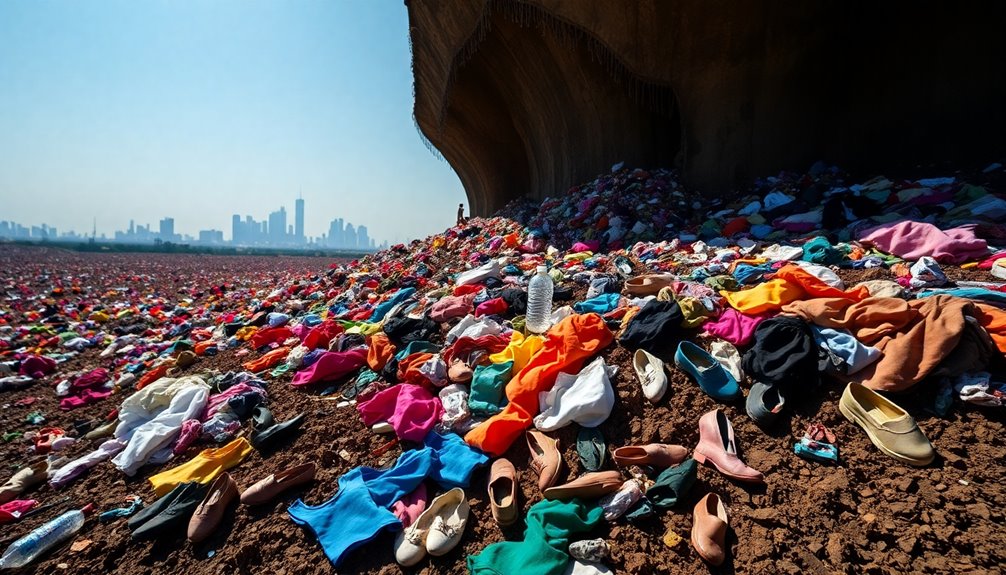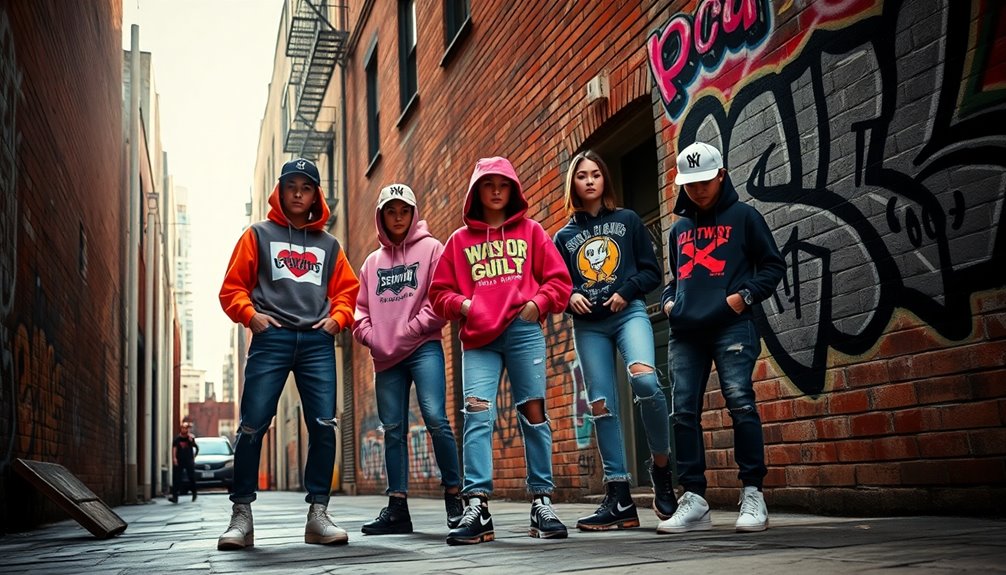Your wardrobe might be harming the planet more than you think. Fast fashion churns out around 80 billion garments yearly, leading to 92 million tons of textile waste. Most clothes end up in landfills or incinerators, while only 12% of materials are recycled. The industry's reliance on synthetic fibers creates long-lasting pollution, and water usage for single items is staggering. Additionally, many workers face exploitation for minimal pay in unsafe conditions. By choosing sustainable brands and better shopping habits, you can reduce your impact. Stick around to discover more ways to transform your wardrobe for the planet's sake!
Key Takeaways
- Fast fashion generates 92 million tons of textile waste annually, significantly contributing to environmental degradation and landfill overflow.
- Clothing production accounts for about 4% of global greenhouse gas emissions, exceeding emissions from aviation and shipping combined.
- The average garment is worn 36% less than in the past, leading to increased overconsumption and waste.
- Over 60 million garment workers face exploitation, often in unsafe conditions, highlighting the social impact of the fashion industry.
- Sustainable practices like renting, upcycling, and supporting ethical brands can help reduce your wardrobe's environmental footprint.
The Fast Fashion Phenomenon

As fast fashion continues to dominate the clothing industry, you mightn't realize the immense environmental and ethical costs it carries.
The fast fashion model churns out around 80 billion garments each year, generating an astonishing 92 million tons of textile waste. Shockingly, 30% of these clothes never find a home and are often incinerated, contributing to significant environmental impact.
With clothing purchases skyrocketing by 400% in the last two decades, the average item is now worn 36% less, fostering a throw-away culture. Additionally, the reliance on synthetic materials leads to microfiber pollution and toxic waste that harm aquatic ecosystems.
Ethical fashion is overshadowed as workers face long hours and minimal pay, raising serious concerns about the true cost of your wardrobe choices.
Environmental Consequences
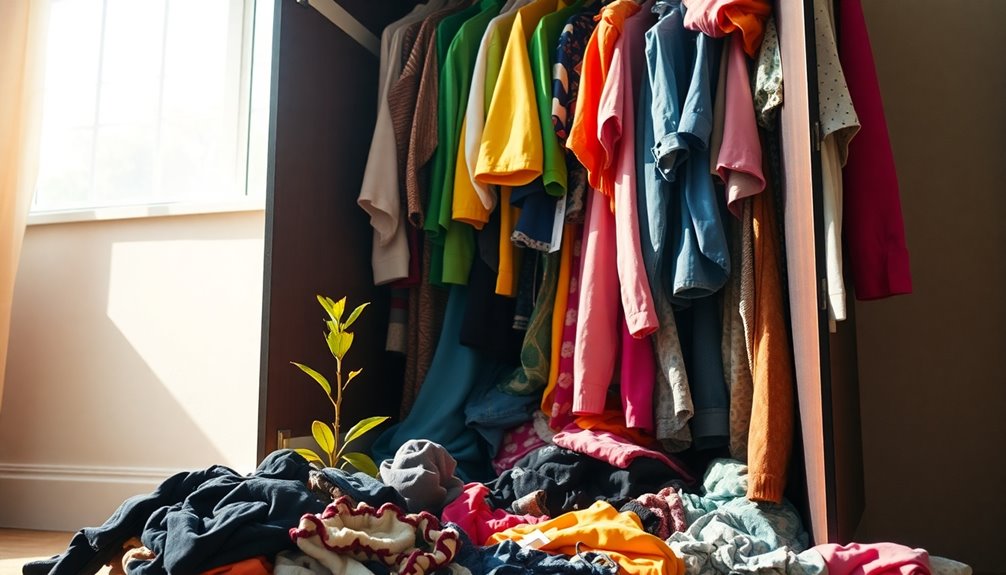
While you may enjoy the latest fashion trends, it's crucial to recognize the environmental consequences tied to your wardrobe choices.
The fast fashion industry is responsible for about 4% of global greenhouse gas emissions, surpassing the combined emissions from aviation and shipping. This unsustainable model creates approximately 92 million tons of textile waste annually, with a staggering 30% of production going unsold, often incinerated.
Additionally, the manufacturing of a single cotton shirt consumes around 2,700 liters of water, worsening water scarcity.
Synthetic fibers, prevalent in fast fashion, can take up to 200 years to decompose in landfills.
Textile Waste Crisis
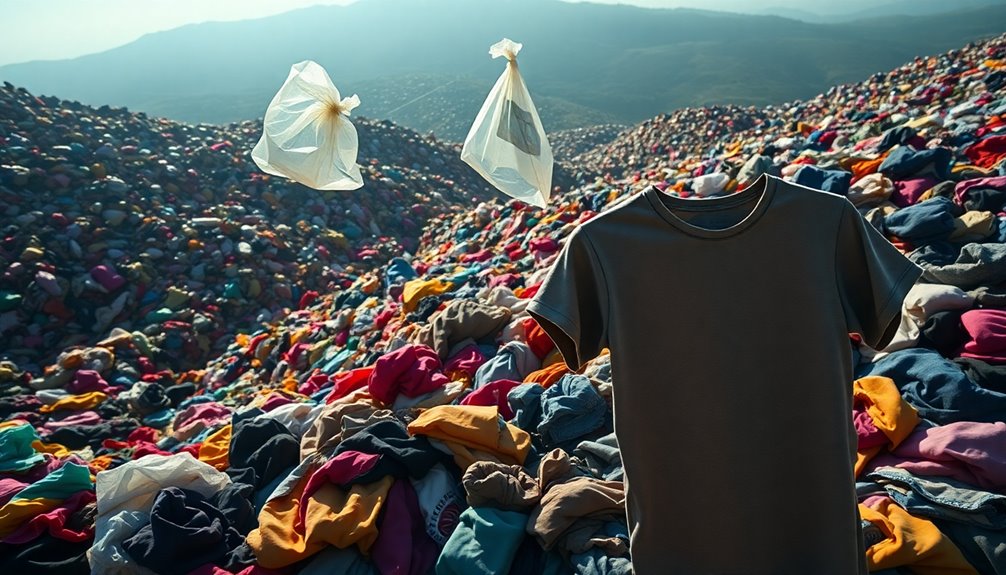
You might be shocked to learn that around 87% of textiles produced end up in landfills or incinerated, a major factor in environmental damage.
Every second, a truckload of textiles is wasted, showcasing the staggering scale of this crisis.
With less than 12% of clothing materials being recycled, it's clear we need to rethink our approach to fashion and waste.
Textile Waste Statistics
Every year, an astonishing 92 million tons of textile waste are generated globally, driven largely by the fast fashion industry. Up to 87% of textiles produced end up in landfills or are incinerated, contributing markedly to environmental degradation.
Imagine one rubbish truck full of textiles being landfilled or burned every second—it's a staggering reality. This annual waste could fill Sydney Harbour multiple times!
Yet, only 12% of clothing materials are recycled, and shockingly, less than 1% of these recycled materials are used to create new clothing.
With about 30% of produced clothes remaining unsold, fast fashion's overproduction exacerbates the textile waste crisis.
It's essential for you to understand the impact of your wardrobe choices on our planet.
Recycling Challenges Today
As the textile waste crisis deepens, recycling challenges persist, hampering efforts to mitigate the environmental impact of fast fashion. The average person contributes considerably to this issue, with 80 pounds of clothing discarded annually.
Here's a snapshot of the recycling landscape:
- Only 12% of clothing materials are recycled.
- Less than 1% of recycled textiles are turned into new clothing.
- About 87% of textiles end up in landfills or incinerated.
- Only 10-40% of donated clothes find new owners.
These statistics highlight the inefficiencies in textile waste management and the urgency for change.
To combat these challenges, you can prioritize sustainable practices, support recycling initiatives, and make mindful purchasing decisions.
Labor Exploitation Issues
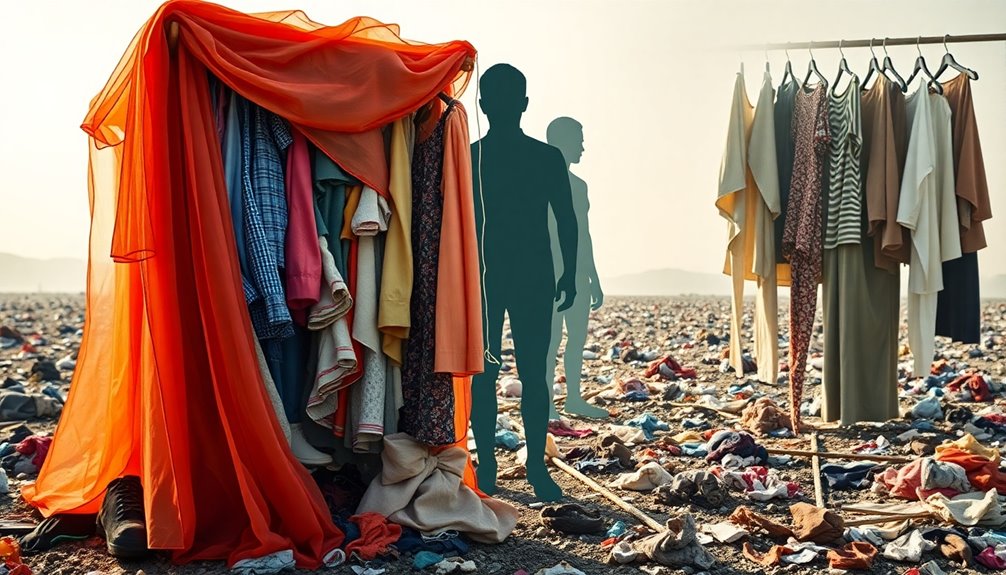
While many enjoy the latest fashion trends, it's crucial to recognize the grim reality faced by over 60 million garment workers in developing nations.
These workers, with 80% being women, often endure labor exploitation in the fast fashion industry. In many regions, they earn as little as $0.50 an hour, and in Ethiopia, the average monthly wage is just $32—far below the cost of living.
This exploitation thrives due to the lack of labor rights protections, allowing brands to maximize profits while neglecting workers' safety. Unsafe working conditions expose them to toxic chemicals, leading to serious health risks. Additionally, many workers are denied access to basic healthcare services, further exacerbating their vulnerability and health challenges.
Marketing Tactics in Fashion
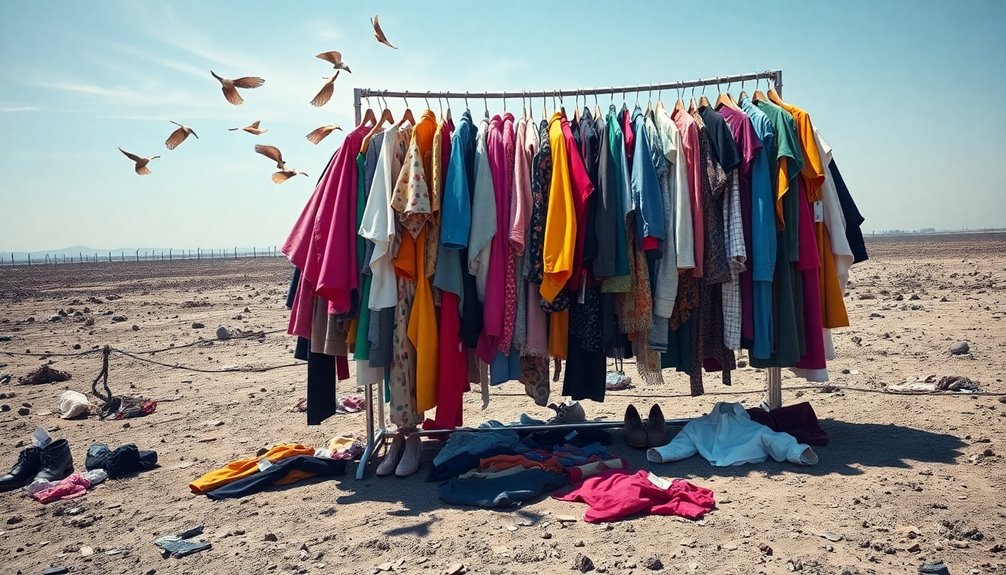
The impact of labor exploitation in the fashion industry doesn't stop at the workers; it extends to how brands market their products.
Fast fashion employs aggressive marketing tactics that drive consumer decisions and promote a throwaway culture. Here's how they do it:
- Frequent Releases: New collections drop multiple times a season, urging you to buy more.
- Impulse Buying: About 75% of consumer decisions are made in under three seconds, capitalizing on quick purchases.
- Shopping as a Hobby: This mindset has led to a 400% increase in clothing purchases over 20 years.
- Rapid Shipping: Same-day shipping options encourage impulse buying, resulting in high return rates and waste.
These strategies push you toward unsustainable consumption without a second thought. Furthermore, the rise of Nike Tech in sneaker culture has contributed to a trend where consumers feel compelled to constantly upgrade their footwear, further fueling the cycle of overconsumption.
Overconsumption and Its Effects
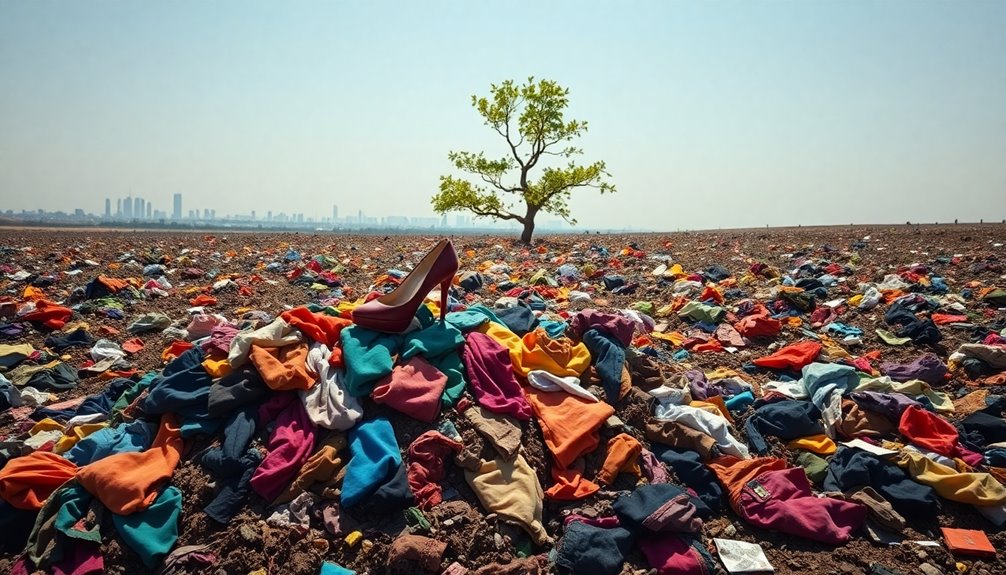
Overconsumption in the fashion industry has serious consequences that reach far beyond your closet.
With clothing purchases surging by 400% over the last two decades, you're part of a cycle that fuels an unsustainable textile industry. Fast fashion encourages you to buy impulsively, resulting in the average garment being worn 36% fewer times than it was 15 years ago.
This throwaway culture leads to about 87% of textiles ending up in landfills or incinerated, generating a rubbish truck's worth of waste every second.
Furthermore, this overconsumption greatly increases your carbon footprint, contributing to environmental degradation.
Circular Economy Solutions
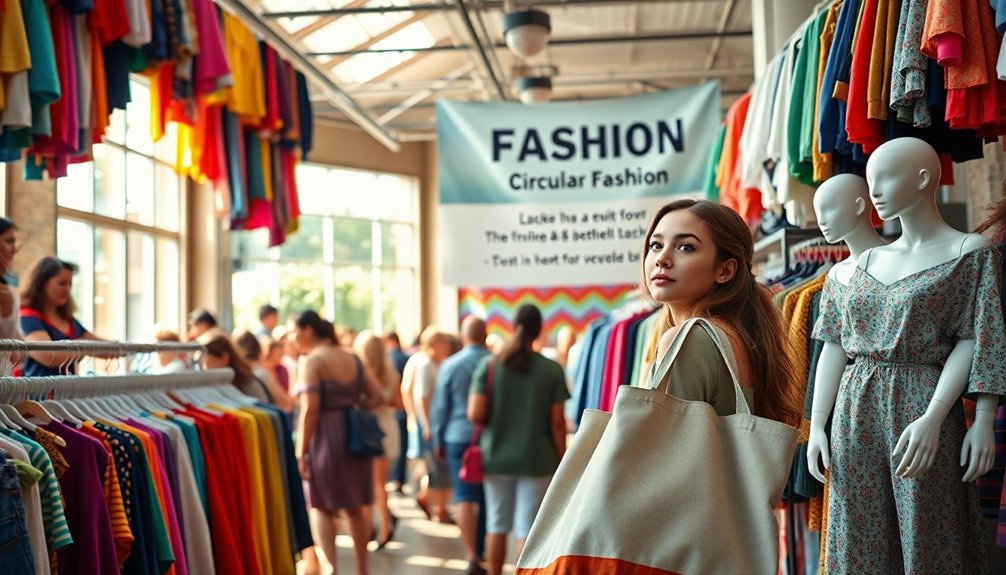
You can contribute to a circular economy by choosing clothing designed for longevity, ensuring your purchases last longer.
Engaging with product stewardship initiatives helps hold brands accountable for their materials and recycling efforts.
Design for Longevity
While many clothing items are designed for quick trends and fleeting use, focusing on design for longevity can transform the fashion industry into a more sustainable space.
By adopting this approach, you can help reduce waste and promote sustainable practices. Here's how:
- Choose high-quality materials that withstand wear and tear.
- Support brands that prioritize craftsmanship and durability.
- Opt for versatile pieces that fit multiple occasions, extending their lifecycle.
- Participate in initiatives like the Usedfully® Textile Reuse Programme to repurpose and recycle garments.
Embracing design for longevity not only minimizes your environmental impact but also cultivates a wardrobe filled with timeless pieces that you'll cherish for years to come. Additionally, being aware of small mistakes in consumer habits can lead to more mindful purchasing decisions.
Let's make thoughtful choices for a healthier planet!
Product Stewardship Accountability
As the fashion industry grapples with its environmental impact, product stewardship accountability emerges as an essential solution for promoting sustainability.
This approach emphasizes that brands must take responsibility for their products from design to end-of-life, ensuring they contribute positively to the circular economy.
By participating in initiatives like the Formary's Usedfully® Textile Reuse Programme, you can help track material flows and reduce textile waste through responsible management.
Registered garments in these stewardship programs can be resold, repaired, or reengineered, creating a sustainable lifecycle and minimizing landfill contributions.
With a forthcoming national voluntary product stewardship scheme on the horizon, the fashion industry is set to enhance recycling and reuse efforts, further supporting a circular economy for textiles.
Textile Reuse Initiatives
Textile reuse initiatives play an essential role in advancing the circular economy by promoting sustainable practices that extend the lifecycle of garments.
Here's how you can get involved:
- Participate in buyback programs: Return old clothing to brands for repurposing.
- Support companies like The Formary: They track material flows and promote textile reuse.
- Educate yourself and others: Share knowledge on sustainable practices to foster community engagement.
- Advocate for increased recycling rates: Currently, only 12% of clothing materials are recycled; push for change.
Additionally, leveraging smart home device integration can enhance sustainable living by optimizing energy usage in your home.
Sustainable Fashion Alternatives

Sustainable fashion alternatives offer a practical way to reduce your environmental impact without sacrificing style. By choosing brands that use organic cotton or recycled materials, you contribute to a significant decrease in water usage and carbon emissions.
Additionally, renting clothes for special occasions or opting for second-hand items can extend the lifecycle of garments, preventing 87% of textiles from ending up in landfills. Supporting local and ethical fashion initiatives fosters transparency and encourages fair labor practices.
You can also engage in clothing swaps or upcycle old garments, diverting waste from landfills. Finally, investing in high-quality clothing means fewer purchases over time, promoting a sustainable wardrobe that values quality over quantity. Incorporating plant-based sources like organic cotton into your wardrobe can further enhance your commitment to sustainability.
Making these choices can lead to a more eco-friendly lifestyle.
Community Engagement in Sustainability

Choosing sustainable fashion alternatives is just the first step in fostering a more eco-conscious lifestyle. Engaging with your community amplifies your efforts and promotes sustainable practices.
Here's how you can get involved:
- Participate in clothing swaps to extend the lifecycle of your garments and reduce textile waste.
- Join local repair workshops where you can learn to fix your clothes, supporting both sustainability and local economies.
- Subscribe to newsletters from organizations like Make.Good to stay informed about sustainable fashion choices and community initiatives.
- Support local brands that prioritize ethical production and engage the community in their supply chain, promoting transparency.
How to Shop Responsibly
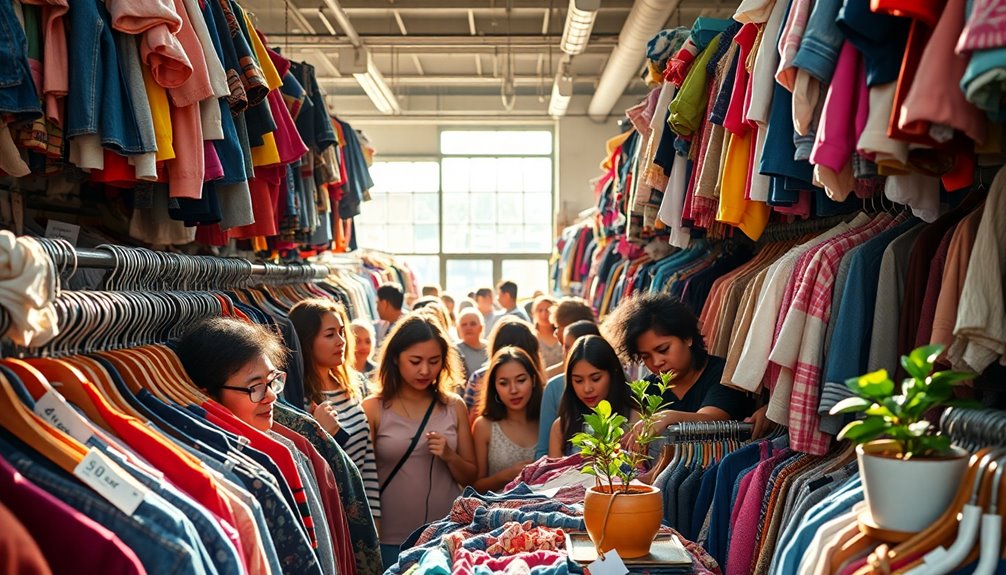
How can you make a positive impact on the planet while updating your wardrobe? Start by choosing sustainable brands that use organic or recycled materials. This reduces environmental harm considerably. Consider clothing swaps or buying pre-owned items to extend garment life and combat overconsumption. Supporting local businesses and ethical fashion initiatives guarantees fair labor practices. Opt for high-quality, durable clothing instead of cheap, disposable items to minimize waste. Finally, be cautious of greenwashing; always look for credible sustainability certifications. Additionally, consider the principles of minimalist lifestyle when curating your wardrobe to further reduce consumption and waste.
| Action | Benefits | Tips |
|---|---|---|
| Choose sustainable brands | Reduces environmental impact | Research brand practices |
| Buy pre-owned | Diverts textiles from landfills | Check thrift stores online |
| Support local businesses | Promotes fair labor practices | Attend local markets |
Frequently Asked Questions
How Bad Is the Fashion Industry for the Planet?
The fashion industry's impact on the planet is alarming. It contributes around 8-10% of global carbon emissions and consumes an astonishing 1.5 trillion liters of water each year.
Fast fashion generates immense textile waste, with millions of tons ending up in landfills or being incinerated. Toxic dyes and chemicals pollute waterways, while synthetic materials release microplastics into our oceans.
You can see how your clothing choices matter in this environmental crisis.
How Bad Is Buying Clothes for the Environment?
Buying clothes can seriously harm the environment. Fast fashion contributes to massive carbon emissions and generates tons of textile waste, most of which ends up in landfills.
Each shirt you purchase uses a staggering amount of water, and washing them releases harmful microfibers into oceans. Plus, synthetic fabrics shed microplastics that damage marine ecosystems.
To make a difference, consider sustainable options and reduce your consumption; your choices can help protect the planet.
What Percentage of Your Wardrobe Do We Wear?
You might feel like a modern-day Cinderella, but instead of a fairy tale, your wardrobe's got a hidden truth.
On average, you wear only about 20% of your clothes regularly. That means a whopping 80% hangs unused, gathering dust.
With fashion trends changing faster than a flick of a wand, it's easy to see why your cherished pieces get neglected.
Consider diving deeper into your closet; you might discover forgotten gems waiting to shine.
Are Clothes Harmful to the Environment?
Yes, clothes can be harmful to the environment. The fashion industry contributes notably to greenhouse gas emissions and water depletion.
For instance, producing one cotton shirt uses around 2,700 liters of water, straining already scarce resources. Toxic dyes can pollute waterways, endangering ecosystems.
Additionally, millions of tons of textile waste end up in landfills each year, and synthetic fabrics take centuries to decompose, worsening pollution and waste management challenges.
Conclusion
In a world where your wardrobe can feel like a time machine, transporting you straight into the heart of environmental chaos, it's essential to make smarter choices. By embracing sustainable fashion, supporting ethical brands, and practicing responsible shopping, you can turn the tide on the fast fashion frenzy. Remember, every small step counts. So, let's swap out those throwaway trends for timeless pieces that honor both our planet and its people—because style shouldn't come at a cost.

